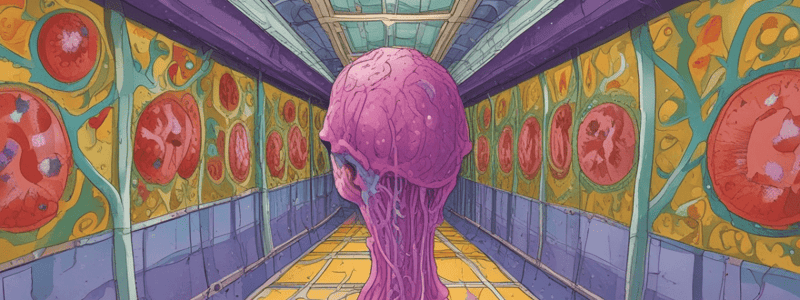Podcast
Questions and Answers
What is the primary result of anaerobic glycolysis during oxygen deprivation?
What is the primary result of anaerobic glycolysis during oxygen deprivation?
- Decrease in ATP production and increase in lactic acid production (correct)
- Decrease in lactic acid production
- Increase in oxidative phosphorylation
- Increase in ATP production
What is the effect of reperfusion injury on cellular pH?
What is the effect of reperfusion injury on cellular pH?
- No effect on pH
- Stabilization of pH
- Increase in pH
- Decrease in pH due to acidosis (correct)
What is the primary cause of mitochondrial damage during cell injury?
What is the primary cause of mitochondrial damage during cell injury?
- Increase in reactive oxygen species
- Decrease in ATP production
- Increase in oxidative phosphorylation
- Lack of oxygen (correct)
What is the characteristic of necrosis in cell injury?
What is the characteristic of necrosis in cell injury?
What is the effect of detachment of ribosomes on protein synthesis?
What is the effect of detachment of ribosomes on protein synthesis?
What is the primary mechanism of cellular damage during reperfusion injury?
What is the primary mechanism of cellular damage during reperfusion injury?
What is the characteristic of reversible cell injury?
What is the characteristic of reversible cell injury?
What is the primary cause of cell injury during ischemia?
What is the primary cause of cell injury during ischemia?
What is the primary cause of swelling in reversibly injured cells?
What is the primary cause of swelling in reversibly injured cells?
What is the hallmark feature of irreversible cell injury?
What is the hallmark feature of irreversible cell injury?
Which of the following is NOT a characteristic of reversible cell injury?
Which of the following is NOT a characteristic of reversible cell injury?
What is the result of toxic injury disrupting metabolic pathways in organs involved in lipid metabolism?
What is the result of toxic injury disrupting metabolic pathways in organs involved in lipid metabolism?
Which of the following is a characteristic of irreversible cell injury?
Which of the following is a characteristic of irreversible cell injury?
What is the primary consequence of ATP depletion in reversibly injured cells?
What is the primary consequence of ATP depletion in reversibly injured cells?
What is the result of detachment of ribosomes from the endoplasmic reticulum in reversibly injured cells?
What is the result of detachment of ribosomes from the endoplasmic reticulum in reversibly injured cells?
What is the primary difference between reversible and irreversible cell injury?
What is the primary difference between reversible and irreversible cell injury?
What is the primary mechanism of cell injury during ischemia?
What is the primary mechanism of cell injury during ischemia?
What is the result of severe and prolonged ischemia?
What is the result of severe and prolonged ischemia?
What is the primary cause of reperfusion injury?
What is the primary cause of reperfusion injury?
What is the result of mild ischemia?
What is the result of mild ischemia?
What is the role of blood in reperfusion injury?
What is the role of blood in reperfusion injury?
What is the mechanism of chemical injury?
What is the mechanism of chemical injury?
What is the consequence of failure of Na pump during ischemia?
What is the consequence of failure of Na pump during ischemia?
What is the consequence of severe swelling of mitochondria during ischemia?
What is the consequence of severe swelling of mitochondria during ischemia?
Flashcards are hidden until you start studying
Study Notes
Cellular Adaptations to Stress
- Hypertrophy: increase in cell and organ size
- Hyperplasia: increase in cell number
- Atrophy: decrease in cell size and number
- Metaplasia: reversible change in cells
- Dysplasia: abnormal development of cells
Cellular Injury
- Causes of cell injury:
- Physical agents (heat, cold, radiation, trauma)
- Oxygen deprivation (hypoxia, ischemia)
- Chemical agents and drugs
- Infectious agents
- Immunologic reactions
- Genetic derangements
- Nutritional imbalances
Reversible vs. Irreversible Injury
- Reversible:
- Cellular swelling due to loss of fluid homeostasis
- Hydrophic changes (liquid accumulation)
- Fatty change (lipid vacuoles)
- Irreversible:
- Necrosis: enzymatic digestion
- Apoptosis: programmed cell death
Ischemia
- Deprivation of oxygen leads to decreased ATP production
- Anaerobic glycolysis occurs, producing less ATP and lactic acid
- Lactic acid lowers pH, affecting proteins and chromatin
- Changes in ion channels and ribosome detachment
Reperfusion Injury
- Restoration of blood flow can cause reperfusion injury
- High dose of oxygen leads to reactive oxygen species (ROS)
- ROS causes cellular damage
- Acidosis (low pH) also occurs
Cell Injury Mechanisms
- Mitochondrial damage: lack of oxygen, decreased ATP, increased ROS
- Physical agents: mechanical trauma, extreme temperatures, radiation, etc.
- Chemical agents and drugs
- Infectious agents
- Immunologic reactions
- Genetic abnormalities
- Nutritional imbalances
Progression of Cell Injury and Death
- Reversible cell injury: functional and structural alterations
- Irreversible cell injury: inability to reverse mitochondrial dysfunction and membrane function
Morphology of Cellular Swelling
- Swelling of cells and organelles
- Blebbing of plasma membrane
- Detachment of ribosomes from endoplasmic reticulum
- Clumping of nuclear chromatin
Cell Death
- Inability to reverse mitochondrial dysfunction
- Profound disturbance in membrane function
- Ischemic cell injury: oxidative phosphorylation fails, ATP decreases
- Ischemia-reperfusion injury: oxidative stress, intracellular calcium overload, inflammation, and activation of complement system
Studying That Suits You
Use AI to generate personalized quizzes and flashcards to suit your learning preferences.




